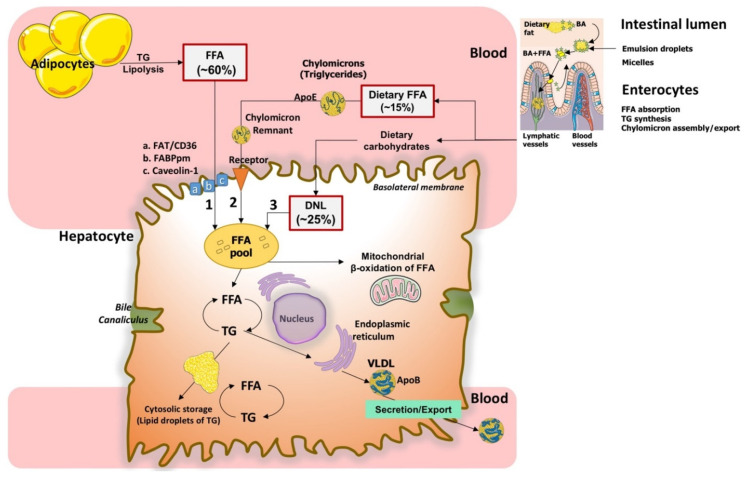Figure 1.
How hepatocytes can provide and metabolize fatty acids. Three major routes provide free fatty acids (FFA) to the liver: (1) circulating FFA (about 60%) made from lipolysis of triglycerides (TG) in adipose tissue [17] can enter the hepatocyte by using specific transporters, (a) the FFA translocase/CD36 transporter, (b) the fatty acid-binding protein (FABP), (c) caveolin-1; (2) dietary FFA (about 15%) contained in TG within ApoE-enriched chylomicrons. These are assembled in the enterocyte following dietary fat digestion in the intestinal lumen by emulsion and micellization with bile acids (BA). In the hepatocyte, chylomicron remnants bind specific membrane receptors with high affinity for the surface protein ApoE; (3) FFA originating from de novo lipogenesis (DNL) (~25%) made mainly from dietary carbohydrates in the hepatocyte. In the hepatocyte, FFA undergo re-esterification with glycerol to form TG stored in small amounts as lipid droplets (less than 5% of cell content). The two major routes of elimination of TG are β-oxidation of FFA in mitochondria and export to blood within very-low-density lipoproteins (VLDL) assembled in the endoplasmic reticulum. In this case, apolipoprotein B (ApoB) undergoes disulfide bond formation and association with TGs by protein disulfide isomerase and microsome triglyceride transfer protein (MTP) at the Golgi apparatus [18]. Abbreviations: BA, bile acids; CD36, fatty acid translocase; DNL, de novo lipogenesis; FABP, fatty acid-binding protein; FFA, free fatty acids; TG, triglycerides VLDL, very-low-density lipoproteins.

